Main Menu · Search ·Current Issue ·Contact ·Archives ·Centennial ·Letters to the Editor ·FAQs
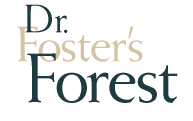 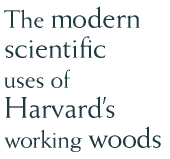
|
After a long climb, up hundreds of stairs and dozens of stories of scaffolding supported by guy wires that are so long they vanish in the distant understory, Dr. David Foster and I emerge from the top of the forest canopy. After the cool dark of the forest below, we are blinded for a few moments by the midday sun. "Up here," says Foster, a Harvard ecologist, "you can really see the size of the forest."
As far as we can see, in every direction, an almost unbroken green canopy rolls and flows over the surrounding hills. The view is indeed impressive, and none the less impressive for not being in Costa Rica or Borneo or some other exotic locale. The forest we are looking down on is wholly owned by the President and Fellows of Harvard College and is just 65 miles west of Harvard Square, in Petersham, a postcard town in central Massachusetts. This is the Harvard Forest, more than 3,000 acres of wooded hills which are, in effect, a giant, bustling outdoor laboratory--where sensors below the canopy automatically take the forest's temperature, where an ancient hemlock grove stands poised for attack by a fast-spreading pest, and where Foster himself once re-created a hurricane to see how the forest would respond.
Foster, 43, is not only the director of the Harvard Forest but also a prominent researcher in his field, which is known as "community ecology"--the study of whole ecosystems. Tall, long-limbed, and thin, soft-spoken and steady, there is something a bit tree-ish about Foster himself--at least until he moves. In the forest, he moves swiftly and surely, naming species as if greeting old friends and reading the history of an area in a stone wall or a fallen oak. Foster (even his name is an anagram of "forest") is also a senior lecturer in biology in Harvard's department of organismic and evolutionary biology (OEB, pronounced "web").
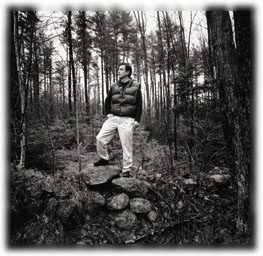 David Foster Photograph by Jim Gipe David Foster Photograph by Jim Gipe |
Most of the forest he directs is covered with trees that have grown up since the land stopped being used for agriculture about a century ago. Lying just north of the vast Quabbin Reservoir (the semi-wilderness area that supplies most of Greater Boston with its drinking water), the Harvard Forest occupies part of a broad band of southern New England that is now more forested, and wilder, than it was in 1898, or 1798, or even--possibly--1698. The area is now home once again to moose, black bears, porcupines, bald eagles, wild turkeys, and, by night, the elusive bobcat and fisher.
By day, the Harvard Forest provides habitat for a diverse community of students and scholars. Widely linked to federal and international researchers, Harvard's forest is a node of intense inquiry just now. Many of those scientists are trying to answer a basic question: can Earth ever recover from having people on it? At Harvard Forest, the preliminary findings point to some early conclusions. In an article published last year, Foster and colleagues wrote that it appears that the insidious impact of man-made "novel stresses" like pollution and global warming present a much greater challenge to a forest than do "natural disasters" like fire or hurricanes.
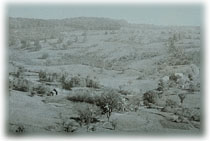  The evolving landscape of the Swift River valley in Petersham, in the 1800s and now. 1800, HARVARD FOREST ARCHIVES; now, JOHN O'KEEFE The evolving landscape of the Swift River valley in Petersham, in the 1800s and now. 1800, HARVARD FOREST ARCHIVES; now, JOHN O'KEEFE |
Questions like these can be addressed at the Harvard Forest in part because it is the oldest continuously studied ecosystem in the United States. Since its establishment in 1907, the forest has yielded a vast databank of maps and plant specimens, as well as detailed measurements of temperature, rainfall, and the like. These are now stored in an archive, one of several buildings that make up the man-made part of the Harvard Forest.
Foster also oversees several smaller forest holdings that belong to Harvard. One is the 25-acre Pisgah Forest in southwestern New Hampshire, which adjoins the 5,000-acre Pisgah State Park. Others include the 100-acre Matthews Plantation in Hamilton, Massachusetts, and a 90-acre forest in Royalston, Massachusetts. In addition, of course, Harvard maintains the separate Arnold Arboretum in Boston, which is more of a living museum of trees from around the world than an intact regional ecosystem.
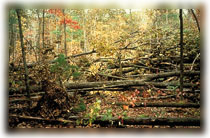 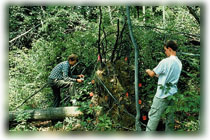 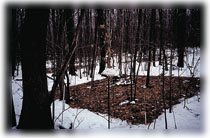 Top: the forest after Foster's simulated hurricane. Middle: measuring vegetation in the "hurricane's" aftermath. Bottom: buried electric cables raise the soil temperature, simulating a waremer climate. Top and bottom, JOHN O'KEEFE; middle, ANN LEZBERG Top: the forest after Foster's simulated hurricane. Middle: measuring vegetation in the "hurricane's" aftermath. Bottom: buried electric cables raise the soil temperature, simulating a waremer climate. Top and bottom, JOHN O'KEEFE; middle, ANN LEZBERG |
"Fundamental research interests have not changed in 80 years," Foster explains during my visit. "But within the last 10 years, the activity level and the involvement of the College have really been transformed." Foster was hired in 1983, when the forest was comparatively "underutilized," with few undergraduates getting much out of it and no summer program. Since then, the forest has brought busloads of students from Cambridge to Petersham and built links to many Harvard departments.
In Harvard administrative terms, the forest is a stand-alone department of the Faculty of Arts and Sciences (FAS), with Foster reporting directly to Dean Jeremy R. Knowles. The forest draws about half its operating budget of $1.6 million a year from its own endowment. Aside from some support from FAS, most of the rest of its funding comes in the form of grants from such sources as the National Science Foundation (NSF), the U.S. Forest Service, the U.S. Department of Energy, and the Mellon Foundation. Significantly, the forest does not depend on funds from the timber or paper industries.
In intellectual terms, the forest is part of many departments--from the Graduate School of Design (for basic ecology and applied research in landscapes) to the Kennedy School of Government (where Charles--no relation--Foster '51, adjunct lecturer in public policy and an associate in the Belfer Center for Science and International Affairs, studies conservation and natural resource management) to the Divinity School (which contemplates environmental ethics) to the School of Public Health (which investigates how changes in landscape affect disease vectors). Not to mention the mainline users in the departments of biology and earth sciences.
What's more, the forest is the heart of a regional scientific community that draws scholars from the University of Massachusetts at Amherst, the University of New Hampshire, and the Ecosystems Center at the Marine Biological Laboratory in Woods Hole, Massachusetts.
Amid all this activity, the forest is perhaps most important for its role since 1988 as part of the NSF-sponsored Long-Term Ecological Research Network (LTER), which now consists of 18 sites extending from Alaska to the Antarctic. Most of the sites are in the continental United States, chosen to represent the major land forms and ecological zones; Harvard's acres of eastern deciduous forest are a prime location for testing long-term climate change. Last fall, the forest was renewed as an LTER site after a scientific review by an NSF panel, which called the research program there "cutting edge."
Although Foster says general research themes have not changed much in half a century, there is in fact a much greater interest these days in how forests work as part of the global biosphere. In the past, directors of the Harvard Forest were more interested in traditional issues of silviculture--how best to grow trees for some specific utilitarian or commercial purpose, like managing a family woodlot or maximizing lumber yields. In the past two decades, the field of ecology has exploded in both public and academic interest, and the forest has become part of that upsurge.
When Foster arrived 15 years ago, there was one ecologist on the staff; now there are 25. There was a single phone line, serving four black rotary phones. Now there are dozens of phones, high-speed data lines, and computers. "I like to think of us as a lab," Foster says. "The advantage of the forest is it's not a park. It's a site of active, top-level international research."